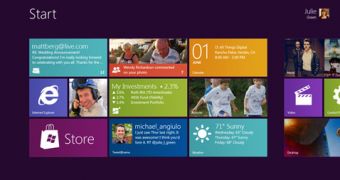The next generation user interface of Windows 8 will be chromeless at core, Microsoft said during its Worldwide Partner Conference 2011. Users that have been watching the evolution of Windows are undoubtedly well aware of the fact that the Windows 8 UI has suffered a major overhaul, especially when the operating system is running on next generation form factors such as Tablet PCs or slates.
Essentially, the old GUI, Windows Aero for example, although still in Windows 8, will be swapped for the new UI on non-traditional form factors. There’s no Taskbar, no Start button, no notifications area, and no desktop. Chromeless.
“Apps are certainly an important part of the Windows 8 plan. And when Windows 8 ships, developers will already know how to build great apps,” said Tami Reller, Corporate Vice President and CFO, Windows & Windows Live.
“The Windows 8 UI is chromeless, and it's clean, and apps can take up the entire screen. Every single pixel on the screen is there to represent your information. As an app comes to life, Windows quickly fades to the background. The apps are beautiful; they're designed for touch and work well with a mouse and keyboard, too.”
Reller is talking about the new HTML5, CSS3 and JavaScript applications that developers will be able to build and have them run directly on top of Windows 8.
With the new Windows 8 chromeless UI, the first thing that will greet users will be the Start Screen, and not the traditional desktop.
In this regard, for Windows 8, Microsoft borrowed a page from the Windows Phone 7 book, and made away with icons, introducing tiles instead.
“The start screen is a personal mosaic of tiles and every app on your system is represented as a tile. Tiles are better than icons because each of the apps has a little more space to show a bit of its personality,” Reeler added.
“The tiles are live. For example, the weather app can show you the current weather without you opening the app itself. You can arrange, you can group and name them however you like. It puts you at the center and makes the experience personal.”
Personally, I fell in love with tiles on Windows Phone 7, and seeing them on Windows 8 next gen form factors just makes sense to me.
Icons are obsolete and overrated. Plus, they’re overused on today’s operating system’s for mobile devices, from smartphones to slates.
Microsoft comes with an entirely different approach, one designed to make Windows 8 stand out of the platform crowd. I call it the NUI + GUI revolution of Windows 8.
“And although this new user interface is designed and optimized for touch, it works equally well with a mouse and keyboard. What you're seeing now, we've even designed a new ergonomic keyboard that puts all of the keys right under your thumb,” Teller stressed.
UPDATE: Changes for clarity. The chromeless UI in Windows 8 refers only to copies of the OS running on next generation form factors.

 14 DAY TRIAL //
14 DAY TRIAL //